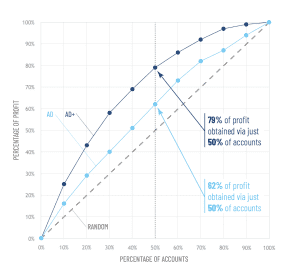This is the first in a series of posts discussing how Recovery Decision Science is using advanced data analytics to revolutionize the debt collection industry.
OVERVIEW
One of the biggest challenges facing the collections industry is weighing the financial risks of litigating a case. We all know that mistakes can be costly. It’s not uncommon for collections professionals to expend significant time, energy, and unnecessary cost chasing down cases with little to no chance of paying back the investment.
Until recently, guesswork has been the norm when it comes to deciding which accounts are worth pursuing in court. Powered by decades of Unifund’s industry leadership and data acumen, Recovery Decision Science created two, revolutionary account-decisioning models: Paymetrix AD and AD+.
Paymetrix AD and AD+ analytical models help creditors identify and prioritizes legal collections decisions, allowing them to collect:
- The most profitable account in the right channels.
- In the right order.
- All while optimizing costs and minimizing waste.
HOW IT WORKS
Paymetrix AD and AD+ help creditors to identify accounts that will pay, while also determining the likelihood of payment. Here’s the process:
- AD is built on an easily-explained model utilizing linear and logistic regression.
- AD+ goes a step further by using advanced machine learning techniques.
- BOTH models identify and prioritize legal collections by first determining the probability of a payment and then determining how much a payment will be (via NPV).
- Using these analytics, a profitability index is developed allowing companies to prioritize the accounts.
PAYMETRIX AD AND AD+ IN ACTION-A REAL-WORLD CASE STUDY
To put AD to the test, we worked with a sample of 50,000 previously-litigated accounts from a major national bank.
But first, let’s review the difference between the two models, AD and AD+:
- Paymetrix AD is an “explainable” model that relies on linear and logistic regression. Some financial institutions prefer the explainable model to satisfy their particular regulatory requirements.
- Paymetrix AD+ is a “black box” model that utilizes advanced, machine-learning techniques. As such, its outputs cannot be explained with the clarity we can achieve through the basic AD model. Because the black-box model delivers superior results (see below), RDS uses AD+ as its default account-decisioning model unless otherwise instructed by our clients.
In building the case study, we wanted to establish a benchmark for comparison to AD and AD+. To that end, we looked at the expected results of a random sample where litigating 50% of the total accounts would yield 50% of the total profits. The grid below shows us the results.

Here’s what we see from the matrix:
- The GREY dotted line is the benchmark of a random sample of accounts.
- The LIGHT BLUE dotted line shows that Paymetrix AD yields 62% of profit via 50% of the accounts, a lift of 12%.
- The DARK BLUE line illustrates the impact on profit by using the machine-learning power of Paymetrix AD+. As you can see, AD+ obtained 79% of the profits from just 50% of the accounts, which translates to a 29% lift vis-à-vis the random sample.
Whether Paymetrix AD or the advanced, machine-learning metrics of AD+, the collections industry now has access to an account-decisioning tool that is able to accurately pinpoint the right accounts to litigate, in the right order.
Let’s summarize the benefits of account-decisioning through the Paymetrix models:
- Innovative, proprietary technology
- High-quality identification and verification accuracy
- The profitability index determines the best treatments
- Priority ranking of accounts
- Industry-leading liquidation results
- Focus, efficient litigation strategy
- Proven cost/benefit search model
To learn more about Recovery Decision Science contact:
Kacey Rask : Vice-President, Portfolio Servicing
[email protected] / 513.489.8877, ext. 261
Error: Contact form not found.
 Here’s what we see from the matrix:
Here’s what we see from the matrix:



